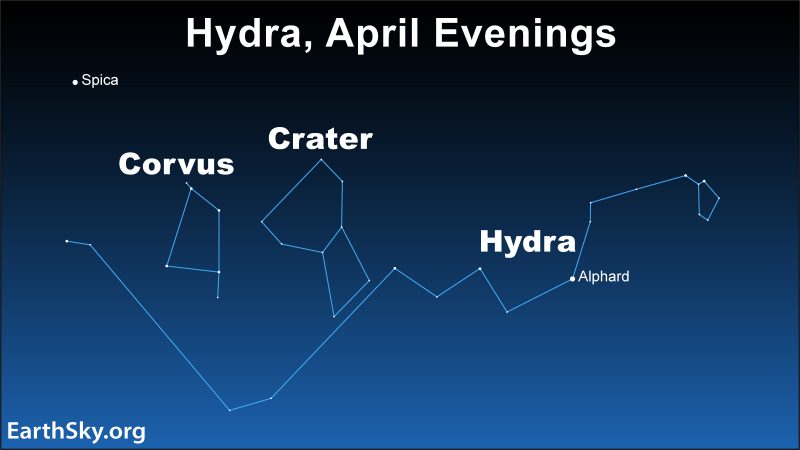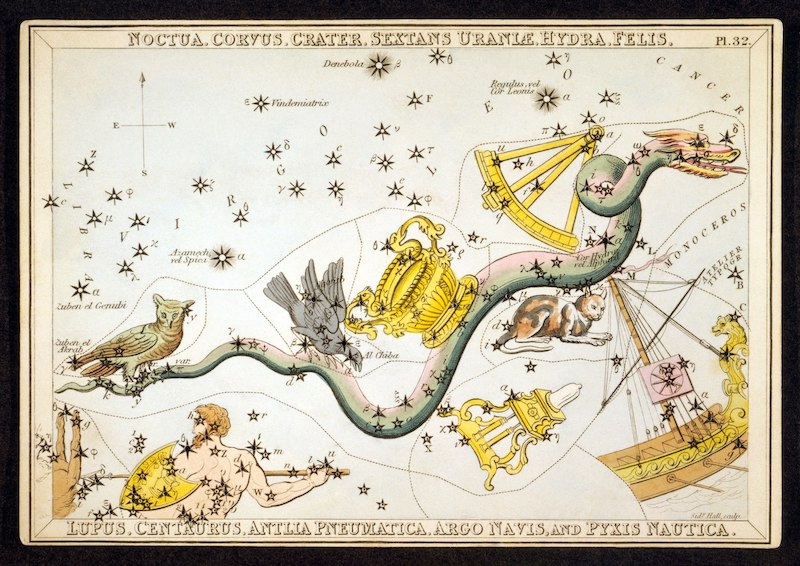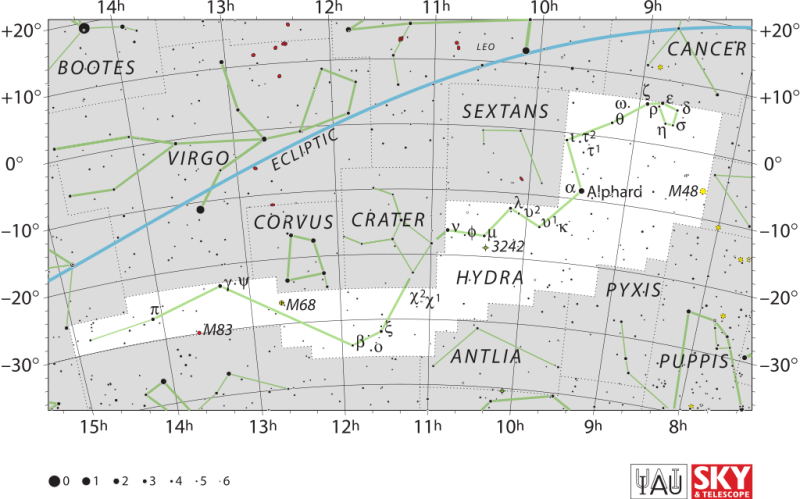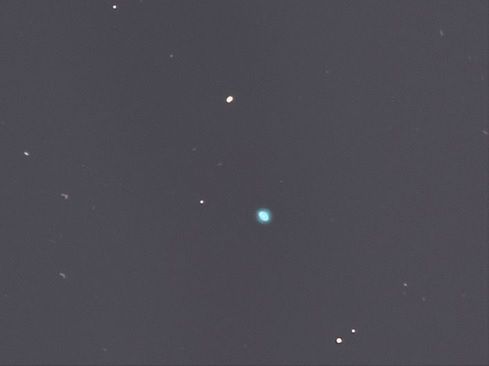
Hydra the Water Snake is the largest of all 88 constellations. It fills the space between zodiacal constellations along the ecliptic on one side and the Milky Way on the other. Hydra’s brightest star is Alphard, which is a sign of spring for the Northern Hemisphere. Moreover, the constellation is home to a variety pack of deep-sky observing targets.
Mythology of Hydra
As you can see from the star chart, two constellations ride upon the back of Hydra the Water Snake: Corvus the Crow and Crater the Cup. One mythological story pairs up these three when the Crow serves the god Apollo a cup of water in which the Water Snake is hiding. Consequently, Apollo, angered by this ruse, throws them all up into the sky.

Finding the constellation Hydra
Hydra is located low in spring skies for observers in the Northern Hemisphere. Indeed, if you’re in the Southern Hemisphere, Hydra swims overhead. The circlet that forms the head of the Water Snake lies below the constellation Cancer the Crab with its famous Beehive Cluster. The body extends away from the head toward the southeast, all the way to Libra.
Stars trace out the Water Snake
Despite its long length, there are only a few stars of note in Hydra. The circlet marking the head of Hydra contains stars from magnitude 3.1 to 4.4. In particular, the brightest in the circlet is Zeta Hydrae at magnitude 3.11. It lies 152 light-years away. Then two degrees away is the next brightest star in this region of Hydra, Epsilon Hydrae at magnitude 3.39, lying 134 light-years away. The 4th magnitude star Rho Hydrae lies between these two, and three other dim stars (Delta at magnitude 4.1, Sigma at magnitude 4.4 and Eta at magnitude 4.2) complete the circlet.
The brightest star in Hydra – Alphard – lies about 16 degrees from the circlet. Additionally, it is 23 degrees south of the bright star Regulus in Leo. Alphard’s other name is Alpha Librae, and it shines at magnitude 1.99. Alphard lies 177 light-years away.

Deep-sky objects in Hydra
There are three Messier objects in Hydra: an open cluster, a globular cluster and a galaxy. In addition, a nice nebula also resides here, giving Hydra one good example of each of the major types of deep-sky observing targets.
M48 is an open cluster on the far western edge of Hydra. It lies 14 degrees from the bright star Procyon in Canis Minor. Comparatively, M48 is magnitude 5.8 and lies about 1,500 light-years away. You can see this open cluster without optical aid under dark skies, but binoculars or a telescope will reveal about 50 of its 80 stars.
Hydra’s exemplary planetary nebula is the Ghost of Jupiter, or NGC 3242. This 9th-magnitude nebula consists of a star at center with a bright nebula and a ghostly cocoon. From our point of view, it takes up about the same amount of sky as Jupiter. The Ghost of Jupiter lies 31 degrees below the body of Leo the Lion.

The globular cluster in Hydra, M68, lies just 3 1/2 degrees below the 2nd brightest star in Corvus. M68 is magnitude 8.19, lying 33,000 light-years away. It’s a good sight through a telescope.
The last Messier object lies 13 degrees east from M68. M83 is a magnitude 7.6 barred spiral galaxy. Part of the Centaurus group of galaxies, M83 – aka the Southern Pinwheel Galaxy – is one of the closer galaxies to Earth at 15 million light-years.
Bottom line: April is a good time to view Hydra the Water Snake, the largest of the 88 constellations.











